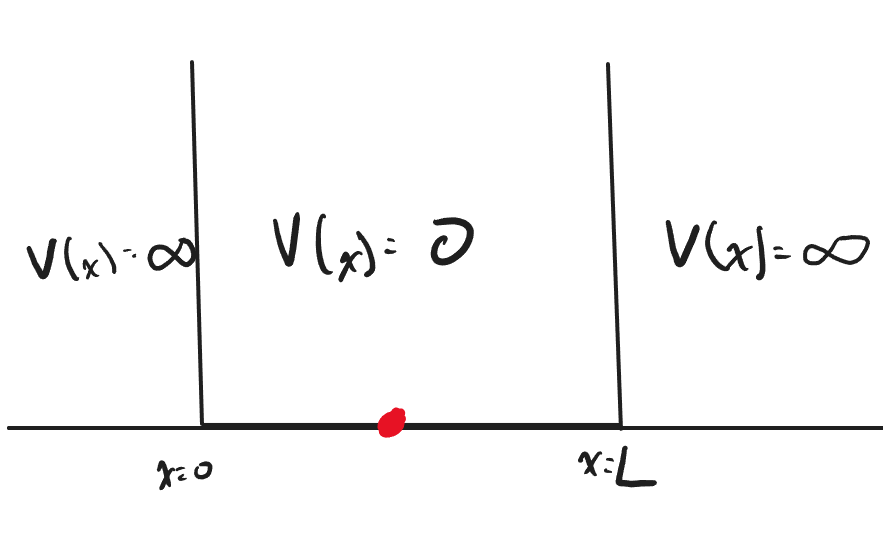Particle in a 1-Dimensional box
claimed by Eathan 4/14/2022 The time-independent Schrodinger Equation is a partial differential equation whose solutions describe the wave function of a quantum system. It is given in the following form. [math]\displaystyle{ -\frac{\hbar^2}{2m}\frac{\partial^2\psi(x)}{\partial x^2} + V(x)\psi(x)= E \psi(x) }[/math]
where
[math]\displaystyle{ \hbar }[/math] is the reduced Planck constant
[math]\displaystyle{ m }[/math] is the mass of the particle
[math]\displaystyle{ \psi(x) }[/math] is the wave function
[math]\displaystyle{ V(x) }[/math] is the potential of the system
[math]\displaystyle{ E }[/math] is the energy of the system
The particle in a 1-Dimensional box is a quantum system in which a particle is bounded in a well with infinite energy at the barrier. Classically, the particle in this system cannot escape. However, in this quantum system, we can demonstrate the particle's quantum tunneling by solving the time-independent Schrodinger Equation.
The Main Idea
Imagine the quantum system shown above, where the particle is bounded by infinite potential energy at [math]\displaystyle{ x = 0 }[/math] and [math]\displaystyle{ x = L }[/math]. The system also has 0 potential energy within the boundaries. We will use these as our boundary conditions to solve for the wave function [math]\displaystyle{ \psi(x) }[/math] below.
A Mathematical Model
We will begin to solve the Schrodinger equation with the boundary conditions as shown above. From the points [math]\displaystyle{ x = 0 }[/math] to [math]\displaystyle{ x = L }[/math], there is 0 potential energy. Using the time-independent Schrodinger Equation with [math]\displaystyle{ V(x) = 0 }[/math], we arrive at the following Schrodinger Equation: [math]\displaystyle{ -\frac{\hbar^2}{2m}\frac{\partial^2\psi(x)}{\partial x^2}= E \psi(x) }[/math]
Isolating the second partial derivative term gives us the following: [math]\displaystyle{ -\frac{\partial^2\psi(x)}{\partial x^2}= -\frac{2mE}{\hbar^2}\psi(x) }[/math]
The general solution to this partial differential equation is very well known and is given here: [math]\displaystyle{ \psi(x) = Asin(kx) + Bcos(kx) }[/math]
Notice how when the potential is 0, the particle behaves as classical physics would predict.
A Computational Model
How do we visualize or predict using this topic. Consider embedding some vpython code here Teach hands-on with GlowScript
Examples
Be sure to show all steps in your solution and include diagrams whenever possible
Simple
Middling
Difficult
Connectedness
- How is this topic connected to something that you are interested in?
- How is it connected to your major?
- Is there an interesting industrial application?
History
Put this idea in historical context. Give the reader the Who, What, When, Where, and Why.
See also
Are there related topics or categories in this wiki resource for the curious reader to explore? How does this topic fit into that context?
Further reading
Books, Articles or other print media on this topic
External links
Internet resources on this topic
References
This section contains the the references you used while writing this page
